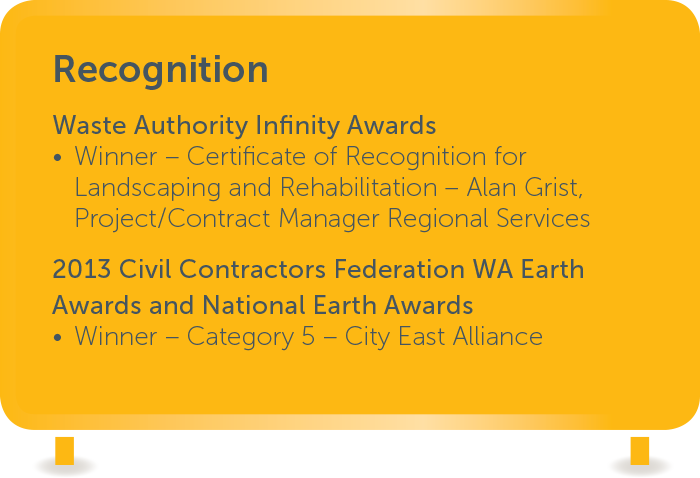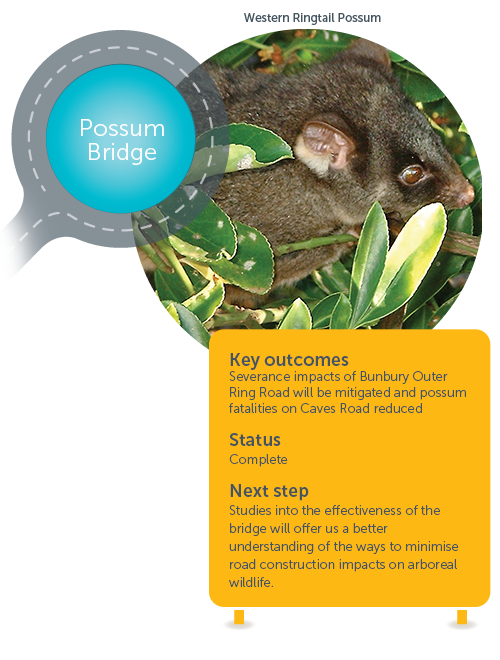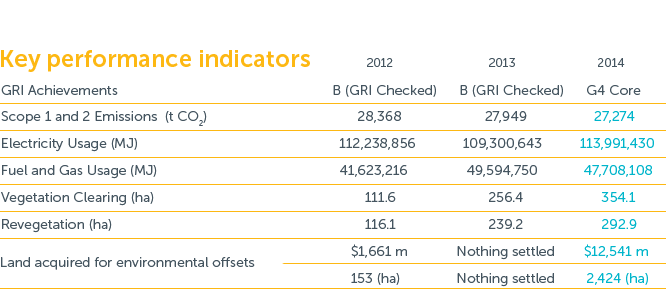 Our road network often adjoins natural areas and in some locations the road verge itself hosts remnant vegetation with high environmental values.
Our road network often adjoins natural areas and in some locations the road verge itself hosts remnant vegetation with high environmental values.
We recognise that the management of the State road network involves a range of activities that have the potential to negatively impact on Western Australia unique environment.
This inspires us to contribute to conservation of the State’s natural assets through avoiding impact where possible and by rehabilitating and enhancing affected areas.
How we stay on track and accountable
Our Corporate Environmental Policy
- Establishes principles of environmental protection, impact minimisation and conservation of natural resources.
The policy is implemented thorughout the organisation through management systems and processes.
Our Environmental Management System
- Addresses all business activity that has environmental aspects and risks
The system defines responsibilities, competencies, procedures and standards, procedures and standards, auditing and review.
Our Environmental Objectives
- Implement a systems-based approach to environmental management
- Seek full compliance with all statutory environmental requirements
- Maintain or improve the biodiversity values of roadsides
- Minimise the impacts of noise associated with the road network
- Protect Aboriginal heritage values of road reserves
- Minimise the environmental impacts of materials used in road construction
- Maximise the efficiency of resources used by Main Roads
- Minimise impacts of roads on water quality
Key Achievements
Transport Portfolio Sustainability Policy
With the creation of the Transport Portfolio the opportunity exists to collaborate with our portfolio colleagues to create a consistent, integrated approach to sustainability through the development of a Transport Portfolio Sustainability Policy.
Building on the draft policy developed during a stakeholder workshop hosted by Roads Australia, the Transport Portfolio Sustainability Policy has been progressed through a working group comprised of representatives from the Department of Transport, Public Transport Authority and Main Roads.The Policy has been approved by the Transport Portfolio Governance Council and is anticipated to be released in 2014-15.
Aboriginal Heritage
We recognise Western Australia’s rich heritage of Aboriginal culture and our planning and development processes include identifying heritage sites and avoiding them wherever possible. Consultation with Aboriginal community representatives is an important step in understanding the extent and significance of heritage localities, particularly when they have not yet been thoroughly recorded. We held four formal meetings this year and increased our specialists’ in-house capability with the appointment of a Principal Heritage Officer.
Environmental Management of Road Projects
Our revised State-wide native vegetation clearing permit requires compliance with a large number of conditions and complex processes. To make sure we address all elements we have:
 All projects are subject to an environmental impact assessment. Screening and preliminary assessment identifies where more detailed field studies are required and when impacts are likely to be significant.
All projects are subject to an environmental impact assessment. Screening and preliminary assessment identifies where more detailed field studies are required and when impacts are likely to be significant.
The following table details the number of road projects and assessment level in the past three years.
| Level of Environmental Assessment | 2011 | 2012 | 2013 |
| Number of road projects subjected to environmental screening | 83 | 114 | 164 |
| Number of road projects for which environmental impact assessment was conducted | 44 | 82 | 97 |
| Number of road projects referred for possible assessment under State or Commonwealth legislation | 2 | 10 | 13 |
| Number of road projects assessed under State or Commonwealth legislation | 1 | 1 | 2 |
| All data is based on calendar year 1 January – 31 December | |||
There were six instances of non-compliance reported this year, all related to the clearing of native vegetation. There were no penalties or financial sanctions relating to the breaches and each of the non-compliances are being addressed through compliance improvement actions
| Environmental Compliance | 2011 | 2012 | 2013 |
| Number of instances of environmental non-compliance reported | 4 | 3 | 6 |
| All data is based on financial year 1 July – 30 June | |||
Carbon Reduction Plan-Climate Change Adaptation and Mitigation
We have developed a Carbon Reduction Plan and Target (5-15% reduction of 2010 levels by 2020) for our Scope One and Two emissions and have progressed a Climate Change Adaptation Plan. Details of various initiatives and achievements that reduce our emissions and energy consumption can be found on our website under the Climate Change section.
Energy Usage and Greenhouse Gas
| Scope 1 or 2 and 3 | Year | ||
| GHG Type (t CO2) | 2012 | 2013 | 2014 |
| Fuel | 2,914 | 3,196 | 3,345 |
| Street and Traffic Lights | 23,400 | 23,031 | 21,830 |
| Buildings | 5,378 | 4,993 | 4,561 |
| Air Travel | 513 | 422 | 318 |
| Maintenance Fuel Use | NA | NA | 9,038 |
| Offsets | -4,535 | -1,792 | -4,501 |
| Total | 27,670 | 29,850 | 34,591 |
| Scope 1 or 2 and 3 | Year | ||
| GHG Category (t CO2) | 2012 | 2013 | 2014 |
| Scope 1 | 2,803 | 3,052 | 3,209 |
| Scope 2 | 25,566 | 24,896 | 24,065 |
| Sub Total | 28,368 | 27,949 | 27,274 |
| Scope 3 | 3,836 | 3,693 | 11,819* |
| Offsets | -4,535 | -1,792 | -4,501 |
| Total | 27,670 | 29,850 | 25,553 |
|
*Note: Maintenance Fuel Usage is a Scope 3 emission and a reporting regime has commenced during 2013-14. |
|||
The level of emissions is on target to achieve our 2020 goal. A total for our scope one and two emissions was to not exceed 30,817t CO2 which was achieved with our calculated emission levels of 27,274 t CO2. The ongoing positive result is due to initiatives rolled out as part of the Carbon Reduction Plan and the continued roll out of LED traffic signal lighting on the road network which now sees over 80% of the network upgraded. Our focus for future reductions is from our street lighting.
Sustainability Assessment in Projects and Operations
We’ve adopted the Infrastructure Sustainability (IS) rating tool, Australia’s only comprehensive rating system for evaluating sustainability across design, construction and operation of infrastructure, for our highest value major projects. All major infrastructure projects with a value over $20 million will utilise the IS framework as part of project development and evaluation. This commitment will also see at least two major projects undergo formal verification and evaluation under the Infrastructure Sustainability Council of Australia’s rating scheme each year. Projects currently registered for formal verification under IS include Gateway WA and NorthLink WA.
Resources for Road Building
Materials
Our main objective in resource conservation is to minimise the environmental impacts of materials used in road construction. We encourage our project partners to recycle and reuse materials and use recycled and ‘environmentally labelled’ materials in all their activities.
When obtaining road building materials we endeavour to avoid clearing natural vegetation, particularly high value vegetation. On-site materials unsuitable for use in road construction is used, as appropriate, for rehabilitating areas where road building materials have been obtained from.
We conduct research into the use of waste materials such as recycled construction and demolition waste in construction practice, current research activities include:
- In-house monitoring and evaluation of pavement trials, such as recycled pavements tested on Forest Highway
- Western Australian Pavement Asset Research Centre project into improving the performance of recycled asphalt mixes
- A joint Main Roads and Waste Authority project evaluating opportunities to increase the use of construction and demolition waste in road construction
- Exploring improving crushed recycled concrete blends with Curtin University
Materials Extracted
| Indicator | 2011 | 2012 | 2013 |
| Imported road construction materials | |||
|---|---|---|---|
| Sand (000s t) | 735.1 | 482.4 | 881.2 |
| Gravel (000s t) | 1,161.0 | 1,013.0 | 1,187.3 |
| Crushed rock (000s t) |
254.0 | 2.4 | 75.8 |
| Limestone (000s t) | 143.7 | 173.4 | 25.1 |
| Aggregate (000s t) | 47.6 | 26.3 | 23.0 |
| Asphalt (000s t) | 83.1 | 51.6 | 59.0 |
| Other (000s t) | 386.7 | 169.3 | 4,015.6 |
| Kerbing, barriers, bridges and culverts | |||
| Concrete (cubic metres) | 10,876 | 26,809.2 | 22,162.9 |
| Other (000s t) | 1.5 | 0.5 | 14.5 |
| All data is based on calendar year 1 January – 31 December | |||
Resources Recycled
| Indicator | 2011 | 2012 | 2013 |
| Waste materials to landfill | |||
|---|---|---|---|
| Kerbing (m) | 3640 | 9779 | 11884 |
| Pavement/footpath (m2) | 3445 | 9041 | 5887 |
| Existing seal (m2) | 215,265 | 227,160 | 109,514 |
| Unsuitable material (m3) | 77,944 | 9,683 | 12,686 |
| Other (m3) | 8,943 | 767 | 1,928 |
| Recycled materials | |||
| Total (000s t) | 74.1 | 59.1 | 140.7 |
| All data is based on calendar year 1 January – 31 December | |||
Water
Water is a precious resource and our State continues to experience the effects of a drying climate. To make sure we do our part in conserving water we encourage practices that reduce our impact on water sources including improving water efficiency and overall water use, utilising recycled water and avoiding the use of potable water. By prioritising the use of non-potable water over scheme water during construction we aim to ease the burden of water scarcity within the communities we work in.
Property Management
Our commitment to commissioning sustainable, environmentally friendly construction continued in this year with the completion of the Wedgefield Laboratory.
The building incorporates solar passive design, insulated roof sheet, double skin insulated walls, efficient lighting, heating and cooling systems and a variety of other water and energy saving measures. These design considerations will result in future efficiencies that will reduce the cost and environmental impact in operating this building over its lifecycle.
Planning for projects at Northam (Wheatbelt Regional Office) and the refurbishment of Don Aitken Centre levels 3, 4 and 6 has also commenced. These projects will adopt new and improved Green Star environmental standards prior to mandatory application of these standards by Building Management & Works, a division of the Department of Finance.
Working with our portfolio colleagues, we continue to improve environmental outcomes across the State through initiatives such as:
- Electrical infrastructure surveys
- Replacement of existing equipment with more environmentally efficient models and
- Continued adoption of 6 star rated residential development to regional areas.
The western ringtail possum, found only in the southwest corner of WA, is currently listed as Endangered and consideration is now being given to amend its status to Critically Endangered. Read More

Habitat loss and fragmentation along with road mortality are impacts faced by the ringtail possum and other wildlife across our road network. Preventing and reversing these impacts is becoming more important as the rates of wildlife extinction and urban development soar worldwide.
To make sure we do our part to preserve this precious native species, we constructed possum rope bridges over the recently completed Stage One of the Bunbury Outer Ring Road and over Caves Road near Busselton.
Installed in 2013, the rope bridges mitigate severance impacts of the new road, connecting fauna habitat and reducing possum fatalities especially in known trouble spots on Caves Road adjacent to the Locke Nature Reserve in Busselton.
Continued monitoring of the rope bridges is being undertaken through an agreement with the University of Western Australia to determine their efficacy in mitigating the severance impacts of roads on arboreal fauna.
The bridges may provide critical information as to whether tree-dwelling animals like the western ringtail possums can be successfully re-connected when separated by roads. The study will show whether rope bridges truly prevent and reverse the impacts of roads on possums and a better understanding of the ways to minimise road construction impacts on wildlife in general.



